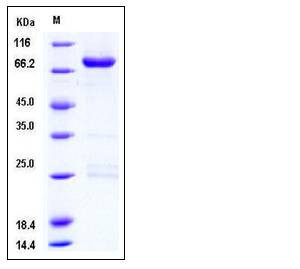Human CLK3 Protein (GST Tag)
PHCLK3,PHCLK3/152
- 100ug (NPP2026) Please inquiry
| Catalog Number | P10716-H09B |
|---|---|
| Organism Species | Human |
| Host | Baculovirus-Insect Cells |
| Synonyms | PHCLK3,PHCLK3/152 |
| Molecular Weight | The recombinant human CLK3/GST chimera consists of 714 amino acids and predicts a molecular mass of 85 kDa. It migrates as an approxiamtely 70 kDa band in SDS-PAGE under reducing conditions. |
| predicted N | Met |
| SDS-PAGE |  |
| Purity | > 89 % as determined by SDS-PAGE |
| Protein Construction | A DNA sequence encoding the human CLK3 isoform b (NP_003983.2) (Met 1-Arg 490) was fused with the GST tag at the N-terminus. |
| Bio-activity | No Kinase Activity |
| Research Area | Cancer |Signal transduction |Protein Kinase |Intracellular Kinase |CLK (CDC-like Kinase) |
| Formulation | Lyophilized from sterile 50mM Tris, 100mM NaCl, pH 8.0, 0.5mM GSH, 0.5mM PMSF, 25% glycerol 1. Normally 5 % - 8 % trehalose, mannitol and 0.01% Tween80 are added as protectants before lyophilization. Specific concentrations are included in the hardcopy of COA. |
| Background | Dual specificity protein kinase CLK3, also known as CDC-like kinase 3, and CLK3, is a member of CMGC Ser/Thr protein kinase family and Lammer subfamily. Mammalian CLK is the prototype for a family of dual specificity kinases (termed Lammer kinases) that have been conserved in evolution. CLK family members have shown to interact with, and phosphorylate, serine- and arginine-rich (SR) proteins of the spliceosomal complex, which is a part of the regulatory mechanism that enables the SR proteins to control RNA splicing. The three members of the CLK family of kinases (CLK1, CLK2, and CLK3) have been shown to undergo conserved alternative splicing to generate catalytically active and inactive isoforms. The human CLK2 and CLK3 are found within the nucleus and display dual-specificity kinase activity. The truncated isoforms, hCLK2(T) and hCLK3(T), colocalize with SR proteins in nuclear speckles. CLK3 may play a role in the development and progression of azoospermia. |
| Reference |
